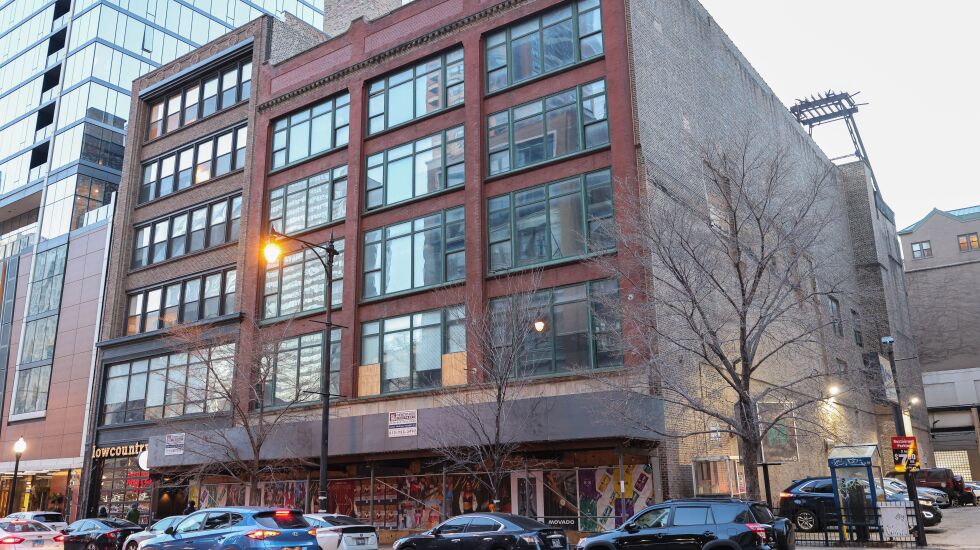
A late 19th century South Loop building that represents an important but relatively unsung chapter of Chicago’s architectural, automotive and technological history is set for demolition.
Built in 1891, the five-story commercial loft structure at 1130 S. Wabash Ave. was the headquarters and showroom for the Woods Motor Vehicle Company.
And from 1899 to 1918, half-forgotten but revolutionary company made one of the world’s first cars powered by gasoline or electricity.
A hybrid car, in other words. A Prius for the gaslight and cobblestone era.
The property’s owner, SBY Wabash LLC, was issued a permit on Nov. 24 to “wreck and remove” the structure, according to the city’s department of buildings.
The owners haven’t submitted any redevelopment plans to the city, according to the Chicago Department of Planning. So it’s unknown what might immediately replace the structure — other than a vacant lot.
In addition to its remarkable car-making history, the former Woods Motor Vehicle building is also a pretty nice example of early Chicago School architecture with its minimalist, grid-like face adorned with three bays of large windows designed to bring in natural light.
It would be a mark against the city’s architectural heritage to lose a building of this character and pedigree.
“This [building] would be a great candidate for landmark designation,” said Preservation Chicago Executive Director Ward Miller. “We’re encouraging the city to reevaluate the demolition permit and to make some determinations if the building can be saved.”
A hybrid 82 years before Honda and Toyota?
The Massachusetts-born Clifton Edgar Woods was an inventor and engineer, and — however briefly — part of the turn-of-the-century constellation of tinkerers, businessmen and madmen who hoped to make it big as automakers.

The Woods Motor Vehicle Company made gas-powered cars and electric ones. Both were displayed in the company’s showroom at 1130 S. Wabash.
But in 1916, the carmaker made space in the South Loop building for his Big Idea: The Woods Dual-Power, an auto that could run on either gas or a bank of batteries.

“The Woods car was a complete hybrid, 82 years before Honda and Toyota got into the business,” Engineering Professor Emeritus John H. Lienhard said last April on the University of Houston’s The Engines of Our Ingenuity podcast.
“Both the engine and brakes drove an electric generator that charged batteries,” he said. “The batteries could either supplement the modest 12-horsepower engine at higher speeds, or they could power the car by themselves.”
But the car flopped, as did all early electric-powered vehicles. Gasoline was cheap, and electrical charge times were too long.
And the prices of the cars were quite steep. According to the Henry Ford Museum of American Innovation, the 1916 Dual-Power coupe was $2,650, while a new 1916 Ford Model T Touring Car could be had for just $360.
Woods Motor Vehicle went belly-up in 1918, two years after the Dual-Power hit the streets.
Save the Woods — and South Wabash, too
The former Woods Motor Vehicle building is not a protected landmark.
And despite being an intact and functioning example of Chicago School architecture, the structure isn’t even listed in the city’s Chicago Historic Resources Survey, a quarter-century old document that’s hurting for an update.
If the building were included in the survey and rated “orange” or higher — and it no doubt would have been — the listing would have triggered a 90-day delay in approving the demolition permit, allowing the city to investigate if the structure is worthy of landmark status.
Here’s where the Department of Planning and its Landmarks Division should step in, albeit carefully.
The city must weigh the cost of revoking a legally-obtained city permit against the the greater wrong of letting yet another historic Chicago building get wiped away and replaced by who-knows-what?
Besides, Chicago knows how to stand up for buildings that represent this town’s automotive history.
By coincidence, 23 years ago this month, the city designated the Motor Row Landmark District, saving 28-acres of early car-related buildings and showrooms south of Cermak Road from getting steamrolled by the westward expansion of McCormick Place.
Saving the Woods Motor Vehicle building could also strike a blow against the architectural mishmash developing along Wabash Avenue, where fine low-rise historic structures are getting the elbow from over-scaled and mediocre newer residential high rises between Balbo Drive and Roosevelt Road.
Either way, the Woods Motor Vehicle building shouldn’t be demolished. And it certainly shouldn’t go down without a fight.
A building that so accurately beckoned the future is too important to be consigned to the past.
Lee Bey is the Chicago Sun-Times architecture critic and a member of the Editorial Board.
Send letters to letters@suntimes.com







